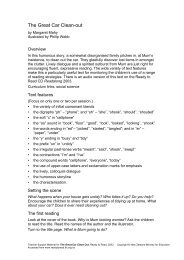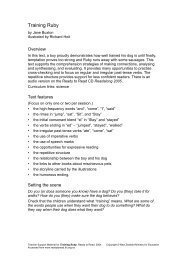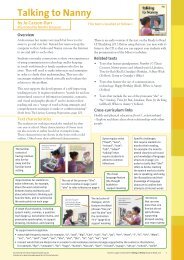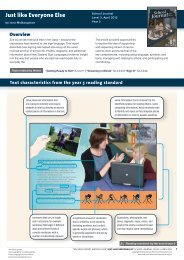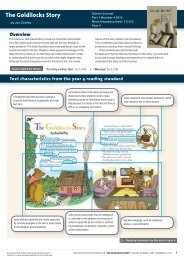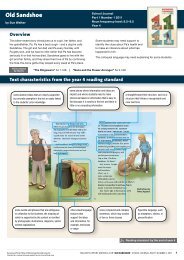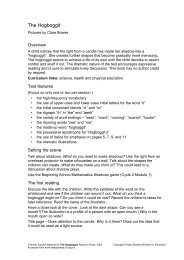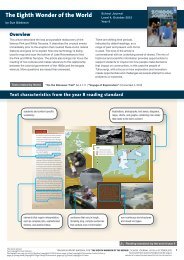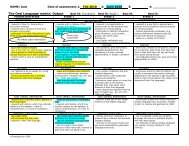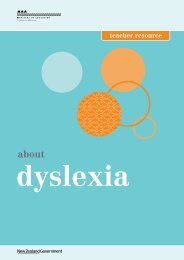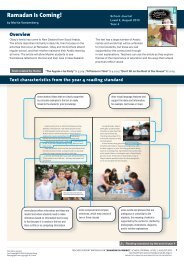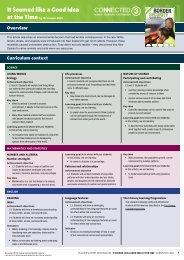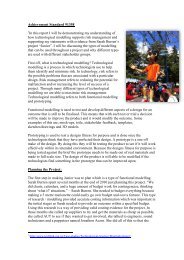L2 August 2011 â Mihi and the Foghorn Father - Literacy Online
L2 August 2011 â Mihi and the Foghorn Father - Literacy Online
L2 August 2011 â Mihi and the Foghorn Father - Literacy Online
- No tags were found...
You also want an ePaper? Increase the reach of your titles
YUMPU automatically turns print PDFs into web optimized ePapers that Google loves.
<strong>Mihi</strong> <strong>and</strong> <strong>the</strong> <strong>Foghorn</strong> Fa<strong>the</strong>rby Rachel HaywardSchool JournalLevel 2, <strong>August</strong> <strong>2011</strong>Year 4OverviewFamily relationships <strong>and</strong> <strong>the</strong> need for honesty are <strong>the</strong> <strong>the</strong>mes ofthis charming story about a girl <strong>and</strong> her over-enthusiastic Dad.<strong>Mihi</strong> loves her Dad, but when he watches her play rugby, hisloud advice <strong>and</strong> encouragement put her off her game. When shebravely lets Dad know this, he makes a deal with her that helps<strong>the</strong>m both to enjoy <strong>the</strong> match.The story provides opportunities formaking connections within <strong>the</strong> textas well as making inferences basedon students’ own knowledge of familyrelationships. The story is an excellent model for writing due to itsrich descriptive language <strong>and</strong> expressive dialogue.Texts related by <strong>the</strong>me “Catch of <strong>the</strong> Day” SJ 3.3.09 | “Operation Flax” SJ 3.1.08 |“Baked Beans on Toast” SJ 3.3.05Text characteristics from <strong>the</strong> year 4 reading st<strong>and</strong>ardsome abstract ideas that are clearly supportedby concrete examples in <strong>the</strong> text or easily linkedto <strong>the</strong> students’ prior knowledgesome places where information <strong>and</strong> ideas are implicit<strong>and</strong> where students need to make inferences based oninformation that is easy to find because it is nearby in<strong>the</strong> text <strong>and</strong> <strong>the</strong>re is little or no competing informationsome compound <strong>and</strong> complex sentences,which may consist of two or three clausessome words or phrases that are ambiguousor unfamiliar to <strong>the</strong> students, <strong>the</strong> meaning ofwhich is supported by <strong>the</strong> context or clarifiedby photographs, illustrations, diagrams, <strong>and</strong>/orwritten explanationsfigurative language, such asmetaphors, similes, or personificationReading st<strong>and</strong>ard: by <strong>the</strong> end of year 4Accessed from http://literacyonline.tki.org.nzCopyright © New Zeal<strong>and</strong> Ministry of Education <strong>2011</strong>Teacher support material for “MIHI AND THE FOGHORN FATHER”, School Journal, LEVEL 2, <strong>August</strong>, <strong>2011</strong>1
Possible curriculum contextsHealth <strong>and</strong> Physical Education (Relationshipswith O<strong>the</strong>r People)Level 2 – Relationships: Identify <strong>and</strong> demonstrateways of maintaining <strong>and</strong> enhancing relationshipsbetween individuals <strong>and</strong> within groups.English (Reading)Level 2 – Language features: Show someunderst<strong>and</strong>ing of how language features areused for effect within <strong>and</strong> across texts.English (Writing)Level 2 – Language features: Use languagefeatures appropriately, showing someunderst<strong>and</strong>ing of <strong>the</strong>ir effects.Possible reading purposes• To find out how <strong>Mihi</strong> <strong>and</strong> her “foghorn fa<strong>the</strong>r” sort out aproblem• To explore <strong>the</strong> relationships between <strong>Mihi</strong> <strong>and</strong> her parents• To underst<strong>and</strong> how well-meaning actions can haveunintended consequences.Possible writing purposes• To write a story about sorting out a problem with a friendor relation• To recount a personal story about a relative• To describe a time when you felt nervous about doingsomething.See Instructional focus –Reading for illustrationsof some of <strong>the</strong>se readingpurposes.See Instructional focus –Writing for illustrationsof some of <strong>the</strong>se writingpurposes.The New Zeal<strong>and</strong> CurriculumText <strong>and</strong> language challengesVocabulary:• Possible unfamiliar words <strong>and</strong> phrases, including “ceiling”,“rugby day”, “nervous”, “eels”, “squirming”, “burst”,“lazybones”, “cheerfully”, “tumbling”, “leaping”, “stomach”,“enthusiastic”, “encouraging”, “foghorn”, “bellowed”, “fright”,“snatched”, “tackle”, “knocked”, “concentrate”, “worried”,“disappointed”, “sigh”, “hesitated”, “piped up”, “blocksher ears”, “laughed”, “swallowed”, “surprised”, “realised”,“scramble”, “miserable”, “deal”, “sailed”, “boomed”,“horrified”, “support”, “whistle”, “high-fived”, “victory dance”,“clamped”, “firmly”, “whoop”, “scattered”, “clubrooms”• The sporting terminology: “a close game”, “half-back”, “madea break for <strong>the</strong> try line”, “tackle”, “half-time”, “play hard”,“play fair”, “kick-off”, “dodged”, “side-stepped”, “passed <strong>the</strong>ball wide”, “team-mates”• colloquial language: “tummy”, “lazybones”, “high-fived”, “letout a whoop”.Specific knowledge required:• Knowledge of family groups <strong>and</strong> dynamics• The concept of respect for <strong>the</strong> feelings of o<strong>the</strong>rs, including beingtactful• Experiences of playing <strong>and</strong>/or watching a team sport.Text features <strong>and</strong> structure:• The implied information about <strong>the</strong> family dynamics, includingwhy <strong>Mihi</strong> feels nervous, why Mum can’t come, <strong>and</strong> why <strong>Mihi</strong>can’t tell Dad her problem• The extended metaphor that describes feeling nervous• The use of metaphors – “butterflies in <strong>the</strong>ir tummy”, “<strong>the</strong> eels… in her stomach”, “Keep your mind on <strong>the</strong> game”, “a little hardstone”, “keep your eye on <strong>the</strong> ball”• The simile – “voice like a foghorn”• The expressive dialogue that uses font variations (italics, largersize, bold, capitals), punctuation, <strong>and</strong> alternatives to “said” fordramatic effect• The use of verbs as adjectives – “squirming, twisting eels”• The construction “The more …, <strong>the</strong> more …”.Possible supporting strategiesSupport <strong>the</strong> rich descriptive language in this story by discussing <strong>the</strong> words <strong>and</strong>phrases (often metaphors or similes) that describe feelings <strong>and</strong> ways of speaking.Guide discussion to support <strong>the</strong> students to share <strong>and</strong> compare ideas to find <strong>the</strong> bestexplanation of what each example conveys. Support students in selecting vocabulary<strong>the</strong>y will focus on learning <strong>and</strong> provide opportunities for <strong>the</strong>m to encounter <strong>and</strong> use<strong>the</strong> vocabulary over time <strong>and</strong> in a range of contexts. The English Language LearningProgressions: Introduction, pages 39–46, has some information about learningvocabulary.Read <strong>the</strong> title aloud. Break <strong>the</strong> word “foghorn” into two parts. Elicit <strong>the</strong> meanings of “fog”<strong>and</strong> “horn”, <strong>the</strong>n encourage students to predict <strong>the</strong> meaning of “foghorn” <strong>and</strong> of “foghornfa<strong>the</strong>r”. Establish that speaking <strong>and</strong> ways of speaking play a large part in <strong>the</strong> story. Elicitsome examples students could use to describe ways of speaking. Ask pairs to list waysof speaking <strong>and</strong> <strong>the</strong>n to share <strong>the</strong>m with <strong>the</strong> rest of <strong>the</strong> group (prompt for “yelled” <strong>and</strong>perhaps “roared”). Start a wall chart of speaking verbs. During reading, invite students tonote <strong>and</strong> share interesting speaking verbs <strong>and</strong> o<strong>the</strong>r ways to describe speaking, <strong>and</strong> add<strong>the</strong>m to <strong>the</strong> chart. During writing, remind students to use <strong>the</strong> chart for ideas.Possible supporting strategiesProvide opportunities for students to discuss how we deal with problems in relationships,including <strong>the</strong> need for tact. Draw out <strong>the</strong> tensions that can arise when <strong>the</strong>re is a problembut you don’t want to offend or hurt someone’s feelings.Ask students to work in pairs to share <strong>the</strong>ir experiences of being a spectator on <strong>the</strong>sideline at a rugby or o<strong>the</strong>r match. Why do some people yell? What is <strong>the</strong> effect of <strong>the</strong>spectators on <strong>the</strong> players?Possible supporting strategiesSee <strong>the</strong> Vocabulary section for support with <strong>the</strong> metaphors <strong>and</strong> similes.Show pictures of butterflies <strong>and</strong> eels. Ask <strong>the</strong> students how both creatures move. Tell<strong>the</strong>m to imagine what it would feel like if <strong>the</strong>y had butterflies or eels in <strong>the</strong>ir stomach.Have <strong>the</strong>m discuss <strong>the</strong>ir ideas <strong>and</strong> what emotion <strong>the</strong>y think <strong>the</strong> metaphor conveys. Forstudents who share a first language o<strong>the</strong>r than English, encourage <strong>the</strong>m to talk aboutmetaphors for nervousness in <strong>the</strong>ir language. Talk about what <strong>the</strong> use of this metaphorcontributes to <strong>the</strong> writing.If necessary, provide additional support for students to infer <strong>the</strong> implied information, suchas <strong>the</strong> reason <strong>Mihi</strong> feels nervous about rugby day.Encourage small groups of students to read <strong>the</strong> story aloud, acting out <strong>the</strong> sections ofdialogue. Use an audio recording of <strong>the</strong> story to support <strong>the</strong> students’ underst<strong>and</strong>ing of<strong>the</strong> print clues used for expression.Sounds <strong>and</strong> WordsAccessed from http://literacyonline.tki.org.nzCopyright © New Zeal<strong>and</strong> Ministry of Education <strong>2011</strong>Teacher support material for “MIHI AND THE FOGHORN FATHER”, School Journal, LEVEL 2, august, <strong>2011</strong>2
Instructional focus – ReadingHealth <strong>and</strong> PE (Relationships with O<strong>the</strong>r People, level 2 – Relationships: Identify <strong>and</strong> demonstrate ways of maintaining <strong>and</strong> enhancingrelationships between individuals <strong>and</strong> within groups.)English (Level 2 – Language features: Show some underst<strong>and</strong>ing of how language features are used for effect within <strong>and</strong> across texts.)Text excerpts from“<strong>Mihi</strong> <strong>and</strong> <strong>the</strong> <strong>Foghorn</strong>Fa<strong>the</strong>r”Dad was enthusiastic. Hewas encouraging. But he wasreally loud. Mum said he hada voice like a foghorn. <strong>Mihi</strong>had never heard a foghorn,but she knew Dad had <strong>the</strong>biggest voice on <strong>the</strong> sideline.“As for you,” Mum said to Dad,“don’t yell too much.”“I don’t!” said Dad. “Do I,<strong>Mihi</strong>?”<strong>Mihi</strong> hesitated. Amokurapiped up.“You were really loud atnetball last week,” she said.“Alex’s mum blocks her earswhen she st<strong>and</strong>s beside you.”“I’m not that bad!” laughedDad. “Tell <strong>the</strong>m, <strong>Mihi</strong>.”<strong>Mihi</strong> swallowed hard. This washer chance. “You are prettyloud,” she said in a smallvoice. “When you shout, I getnervous <strong>and</strong> mess up.”When <strong>the</strong>y got to <strong>the</strong> field, Dadturned to <strong>Mihi</strong>. “Let’s make adeal,” he said. “You do your bestto help your team win, <strong>and</strong> I’lldo my best to keep quiet.” Heheld out his h<strong>and</strong>. “Deal?”<strong>Mihi</strong> smiled <strong>and</strong> shook his bigh<strong>and</strong>. “Deal!”Students(what <strong>the</strong>y might do)The students use <strong>the</strong>ir vocabularyknowledge to work out <strong>the</strong>meanings of “enthusiastic” <strong>and</strong>“encouraging”.They cross-check with informationearlier in <strong>the</strong> text as <strong>the</strong>y ask<strong>and</strong> answer questions about <strong>the</strong>problem <strong>Mihi</strong> is experiencing.Students use <strong>the</strong>ir strategies <strong>and</strong><strong>the</strong>ir knowledge of languagefeatures to follow <strong>the</strong> dialogue <strong>and</strong>work out who is speaking <strong>and</strong> how<strong>the</strong>y speak.They use clues in <strong>the</strong> text <strong>and</strong><strong>the</strong>ir own knowledge of familyrelationships to infer <strong>the</strong> differencesbetween <strong>the</strong> responses of Mum,Dad, Amokura, <strong>and</strong> <strong>Mihi</strong>. Inparticular, <strong>the</strong>y use <strong>the</strong> words“hesitated”, “swallowed hard”, <strong>and</strong>“small voice” to infer <strong>the</strong> feelings of<strong>Mihi</strong> – about letting Dad know hisloud voice makes her nervous.The students make connectionsbetween <strong>the</strong> text <strong>and</strong> <strong>the</strong>irknowledge of resolving problems toinfer <strong>the</strong> meaning of <strong>the</strong> deal. Theyinfer that Dad underst<strong>and</strong>s how hecan help <strong>Mihi</strong> <strong>and</strong> that <strong>the</strong>y bothhave a responsibility.Teacher(possible deliberate acts of teaching)Prompt <strong>the</strong> students to reread for clues that will help <strong>the</strong>m infer meaning.• Read back over <strong>the</strong> story so far. What parts tell you how <strong>Mihi</strong> was feeling?• What clues help you to infer her problem? (“rugby day”, “She felt sick”, “Thiswas Dad’s rugby weekend”, “She might keep Dad quiet.”)Ask questions to support <strong>the</strong> students to make deeper connections with <strong>the</strong>text. In pairs, have <strong>the</strong>m discuss <strong>the</strong>ir ideas about parents on <strong>the</strong> sidelines <strong>and</strong><strong>the</strong>n have <strong>the</strong>m share <strong>the</strong>se with <strong>the</strong> group.• What do you think parents <strong>and</strong> family feel about watching <strong>the</strong>ir children playsport?• How do you feel about your family watching?• What does <strong>the</strong> illustration tell you about Dad?• What can <strong>Mihi</strong> do about <strong>the</strong> situation? What would you do?Have <strong>the</strong> students act out this section of dialogue. They can work in small groups,using <strong>the</strong> clues in <strong>the</strong> text to help <strong>the</strong>m express <strong>the</strong> speech of each characteraccurately. Prompt <strong>the</strong>m to pay attention to <strong>the</strong> language that describes ways ofspeaking.Ask questions to help students clarify <strong>the</strong> relationships in <strong>the</strong> family.• What did you learn about <strong>the</strong> relationships between <strong>the</strong> two children <strong>and</strong><strong>the</strong>ir fa<strong>the</strong>r?• Why do you think Amokura speaks up but <strong>Mihi</strong> finds it hard to say what shethinks?• Why do you think Dad appeals to <strong>Mihi</strong>?• Do you think Dad will take <strong>the</strong> concerns of <strong>Mihi</strong> seriously? Why do you thinkthat?• How has <strong>the</strong> writer helped you to underst<strong>and</strong> more about <strong>Mihi</strong> <strong>and</strong> Dad?Prompt <strong>the</strong> students to work with a partner to analyse <strong>the</strong> deal.• Is this a good way to solve <strong>the</strong> problem? What o<strong>the</strong>r way could it have beendone?• How do you think <strong>Mihi</strong> feels now? How can you tell?• Do you think <strong>the</strong>y will keep to <strong>the</strong> deal? What might happen next?If necessary, support students to underst<strong>and</strong> <strong>the</strong> concept of a deal – that it involvesboth parties agreeing to actions for a specific outcome. Use classroom examples toillustrate o<strong>the</strong>r “deals”, such as working hard to earn extra free time.give feedback• You asked good questions about <strong>the</strong> problem <strong>Mihi</strong> was having with her dad.The answers helped you underst<strong>and</strong> why <strong>Mihi</strong> felt so nervous.• You identified some good clues about <strong>the</strong> feelings <strong>Mihi</strong> was having. Theyhelped you to underst<strong>and</strong> that <strong>Mihi</strong> didn’t want to hurt Dad’s feelings.Metacognition• Tell me how you worked out how <strong>Mihi</strong> felt about her dad. Whatclues did you use?• Show me where you went back to reread. Why did you do that?How did it help you?• Tell me how you made connections to o<strong>the</strong>r situations in yourfamily even though none of you play sport.Reading st<strong>and</strong>ard: by <strong>the</strong> end of year 4The <strong>Literacy</strong> Learning ProgressionsAssessment Resource BanksAccessed from http://literacyonline.tki.org.nzCopyright © New Zeal<strong>and</strong> Ministry of Education <strong>2011</strong>Teacher support material for “MIHI AND THE FOGHORN FATHER”, School Journal, LEVEL 2, august, <strong>2011</strong>3
Instructional focus – WritingHealth <strong>and</strong> PE (Relationships with O<strong>the</strong>r People, level 2 – Relationships: Identify <strong>and</strong> demonstrate ways of maintaining <strong>and</strong> enhancingrelationships between individuals <strong>and</strong> within groups.)English (Level 2 – Language features: Use language features appropriately, showing some underst<strong>and</strong>ing of <strong>the</strong>ir effects.)Text excerpts from“<strong>Mihi</strong> <strong>and</strong> <strong>the</strong> <strong>Foghorn</strong>Fa<strong>the</strong>r”Some people get butterfliesin <strong>the</strong>ir tummy when<strong>the</strong>y’re nervous, but <strong>Mihi</strong>had eels – squirming,twisting eels.…<strong>Mihi</strong> felt <strong>the</strong> eels tumbling<strong>and</strong> leaping in her stomach.…There were no more eels inher stomach – just a littlehard stone.“TACKLE HER!” roared Dad.<strong>Mihi</strong> tripped, crashed intoone of her team-mates, <strong>and</strong>knocked her over.…Dad’s voice boomed, “KEEPYOUR EYE ON THE BALL, MIHI!”…“SORRY!” he shouted. He puthis h<strong>and</strong> over his mouth <strong>and</strong>kept it <strong>the</strong>re.…She dodged <strong>and</strong> side-stepped.…Dad was doing a little victorydance, his h<strong>and</strong> clamped firmlyover his mouth.Examples of textcharacteristicsEXTENDED METAPHORWhen a metaphor is continuedacross a text, <strong>the</strong> reader can comparechanges as <strong>the</strong> story progresses. Thishelps <strong>the</strong> reader to better underst<strong>and</strong>what is happening for a character.STRESSThere are several ways a writercan give spoken words a strongemphasis. Using capital letters,italics, <strong>and</strong> punctuation such asexclamation marks all helps <strong>the</strong>reader to underst<strong>and</strong> how <strong>the</strong> writerintends <strong>the</strong> words to be spoken.Word choiceThe more precise <strong>the</strong> word chosen,<strong>the</strong> easier it is for <strong>the</strong> reader tounderst<strong>and</strong> exactly what <strong>the</strong> writerintended.Teacher(possible deliberate acts of teaching)PROMPT <strong>the</strong> students to review what <strong>the</strong>y know about metaphors.• Have you used metaphors in your writing?• What effect do you want <strong>the</strong>m to have?If appropriate, provide opportunities for your students to explore metaphors(for being nervous, initially) in <strong>the</strong>ir first language, ei<strong>the</strong>r with a partner whoshares <strong>the</strong> same first language or by describing <strong>the</strong>m to you. Discuss, <strong>and</strong> giveexamples of, <strong>the</strong> way metaphors often don’t translate well.Model how <strong>the</strong> extended metaphor in <strong>the</strong> extracts helps you to underst<strong>and</strong><strong>the</strong> changes in <strong>the</strong> feelings <strong>Mihi</strong> is having. Read each extract aloud, sharing <strong>the</strong>feeling you get as <strong>the</strong> metaphor changes.DIRECT <strong>the</strong> students to review <strong>the</strong>ir own writing to find places where ametaphor could help convey an idea or a feeling.• Ask a partner to read your writing. Talk about <strong>the</strong> ideas or feelings you wantto convey.• Would a metaphor be a good way of expressing your feelings? Is <strong>the</strong>metaphor you’ve used a good one?• Would it help to use <strong>the</strong> same one again in <strong>the</strong> story, with some changes toshow how a character has changed?PROMPT <strong>the</strong> students to “write like a reader” by reading <strong>the</strong>ir story aloud orsilently.• Imagine you’re reading your story aloud to an audience. How do you want<strong>the</strong> characters to sound when <strong>the</strong>y speak?• How can you help your readers to know that? Can you use <strong>the</strong> way youwrite <strong>the</strong> words <strong>and</strong> <strong>the</strong> punctuation to show more clearly how you want<strong>the</strong>m to sound?PROMPT <strong>the</strong> students to review <strong>the</strong> verbs <strong>the</strong>y have used.• Check that every verb is working hard for you. Does it say exactly what youmean? If not, use <strong>the</strong> chart to find some alternatives.Model <strong>the</strong> use of precise or specific language. Sometimes students overload<strong>the</strong>ir writing with descriptive language that makes <strong>the</strong> writing turgid or “over<strong>the</strong> top”. Support <strong>the</strong>m <strong>and</strong> <strong>the</strong>ir writing partners to use peer feedback to makedecisions about changing or removing unnecessary words. An analogy such as“using a sledgehammer to put in a drawing pin” may help to explain why somewords are too strong for <strong>the</strong> writer’s purpose.Give feedback to affirm students’ writing decisions <strong>and</strong> guide <strong>the</strong>ir learning.• The metaphor you used helped me to underst<strong>and</strong> Rosie’s feelings. Howcould you extend it to help your readers to see how she changes later?• When I read <strong>the</strong> dialogue, I could imagine just how <strong>the</strong> boys were talking.Reading your writing aloud to Tama has helped you choose verbs that make<strong>the</strong> way <strong>the</strong>y were speaking much clearer.Metacognition• Tell me about <strong>the</strong> process you used to find this metaphor.Did you try out some o<strong>the</strong>r ideas first? Why do you think thisone worked best? Is this a metaphor that is used in your firstlanguage?• Show me where you’ve revised your writing. What did you dohere, <strong>and</strong> why did you do it?• Describe what you did to help your readers underst<strong>and</strong> <strong>the</strong>relationship between Sarah <strong>and</strong> her best friend.Writing st<strong>and</strong>ard: by <strong>the</strong> end of year 4The <strong>Literacy</strong> Learning ProgressionsAccessed from http://literacyonline.tki.org.nzCopyright © New Zeal<strong>and</strong> Ministry of Education <strong>2011</strong>Teacher support material for “MIHI AND THE FOGHORN FATHER”, School Journal, LEVEL 2, august, <strong>2011</strong>4



